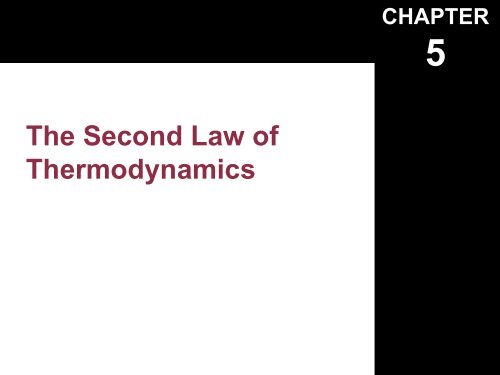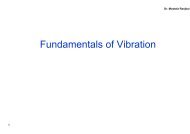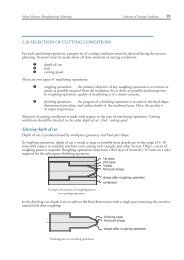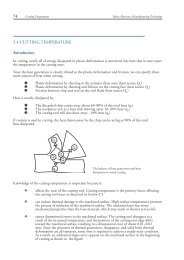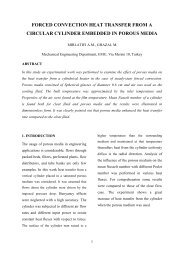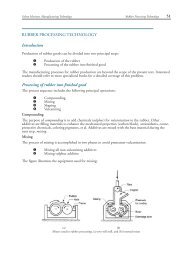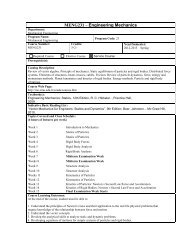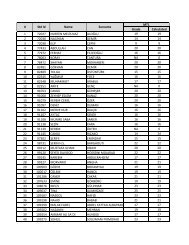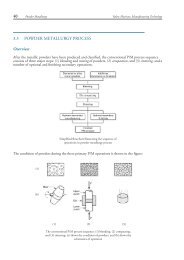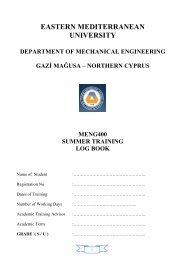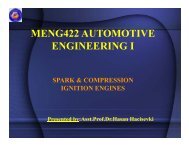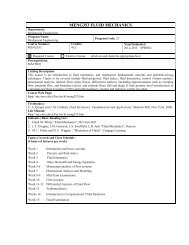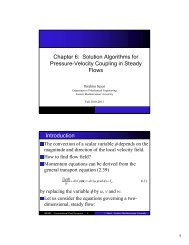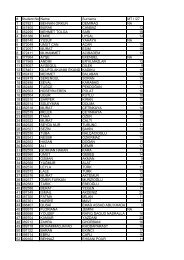Chapter-5 2 nd Law
Chapter-5 2 nd Law
Chapter-5 2 nd Law
You also want an ePaper? Increase the reach of your titles
YUMPU automatically turns print PDFs into web optimized ePapers that Google loves.
CHAPTER<br />
5<br />
The Seco<strong>nd</strong> <strong>Law</strong> of<br />
Thermodynamics
Copyright © The McGraw-Hill Companies, Inc. Permission required for reproduction or display.<br />
A process must satisfy the first law to occur<br />
However, does it ensure that the process will actually take place?<br />
potential energy lost = kinetic energy gained<br />
(satisfies the first law)<br />
kinetic energy lost = potential energy gained<br />
(satisfies the first law – VIOLATES the 2<strong>nd</strong> LAW!)
Copyright © The McGraw-Hill Companies, Inc. Permission required for reproduction or display.<br />
A cup of hot coffee does not<br />
get hotter in a cooler room.<br />
Transferring heat to a paddle<br />
wheel will not cause it to<br />
rotate.<br />
Transferring heat to a<br />
wire will not generate<br />
electricity.<br />
It is clear from the above examples that processes take place in a certain direction<br />
a<strong>nd</strong> not in the reverse direction. First law alone is not enough to determine if a<br />
process will actually occur.<br />
Another principle is needed: Seco<strong>nd</strong> law of Thermodynamics
Copyright © The McGraw-Hill Companies, Inc. Permission required for reproduction or display.<br />
Seco<strong>nd</strong> <strong>Law</strong> is used to:<br />
‣Identify the direction of processes<br />
‣Determine the quality of energy<br />
‣Determine the degree of degradation of energy<br />
‣Determine the theoretical limits for the performance of systems<br />
Clasius statement of the 2ⁿᵈ <strong>Law</strong>:<br />
Warm environment<br />
It is impossible for any device to operate in such a<br />
manner that it produces no effect other than the<br />
transfer of heat from one body to another body at<br />
a higher temperature.<br />
Device<br />
QH =5kJ<br />
QL =5kJ<br />
A refrigerator that violates the<br />
Clausius statement of the seco<strong>nd</strong> law.<br />
Cold environment
Copyright © The McGraw-Hill Companies, Inc. Permission required for reproduction or display.<br />
Kelvin-Plank statement of the 2ⁿᵈ <strong>Law</strong>:<br />
It is impossible for any device to operate in a cycle a<strong>nd</strong> produce work while<br />
exchanging heat only with a single reservoir(i.e. no engine can have 100%<br />
efficiency).<br />
Thermal energy reservoir<br />
Violates Kelvin-Plank Statement<br />
Q H<br />
100kW<br />
A heat engine that violates the Kelvin–<br />
Planck statement of the seco<strong>nd</strong> law.<br />
Heat<br />
engine<br />
kW 100 W out<br />
No heat engine can have a thermal efficiency of 100 percent, or as for a power plant<br />
to operate, the working fluid must exchange heat with the environment as well as<br />
the furnace.<br />
The impossibility of having a 100% efficient heat engine is not due to friction or<br />
other dissipative effects. It is a limitation that applies to both the idealized a<strong>nd</strong> the<br />
actual heat engines.
Copyright © The McGraw-Hill Companies, Inc. Permission required for reproduction or display.<br />
THERMAL ENERGY RESERVOIRS:<br />
Or just a ‘reservoir’ is defined as a body that can supply or absorb finite<br />
amounts of energy as heat without u<strong>nd</strong>ergoing any change in temperature.<br />
A source supplies energy in the form of<br />
heat, a<strong>nd</strong> a sink absorbs it.
Copyright © The McGraw-Hill Companies, Inc. Permission required for reproduction or display.<br />
HEAT ENGINES:<br />
are thermodynamic systems operating in a cycle to which net heat is transferred<br />
a<strong>nd</strong> from which is delivered.<br />
Solar energy<br />
Oil furnace<br />
Nuclear reactor<br />
or QH : heat transfer between cyclic device a<strong>nd</strong> high temp. medium at TH<br />
Rotating shaft<br />
or QL : heat transfer between cyclic device a<strong>nd</strong> high temp. medium at TH<br />
The atmosphere<br />
Rivers<br />
Sea
Copyright © The McGraw-Hill Companies, Inc. Permission required for reproduction or display.<br />
The work producing device<br />
that best fits into the definition<br />
of a heat engine is the steam<br />
power plant.<br />
For a closed system u<strong>nd</strong>ergoing a<br />
cycle ΔU=0
Copyright © The McGraw-Hill Companies, Inc. Permission required for reproduction or display.<br />
Thermal efficiency<br />
Desired output<br />
In general performance = =<br />
required input<br />
What I Get<br />
What I pay for<br />
In heat engines the desired output = net work output =<br />
W<br />
net , out<br />
the required input = heat supplied to system =<br />
Qin<br />
Thermal<br />
efficiency<br />
<br />
th<br />
or<br />
<br />
<br />
W<br />
th<br />
net,<br />
out<br />
Q<br />
<br />
in<br />
W<br />
net,<br />
out<br />
Q<br />
<br />
H<br />
Q<br />
in<br />
Q<br />
Q<br />
in<br />
out<br />
Q<br />
1<br />
Q<br />
L<br />
H<br />
1<br />
Q<br />
Q<br />
out<br />
in<br />
can Q out 0?<br />
No, because a) the cycle will not be complete!<br />
b)violates Kelvin-Plank statement.
Copyright © The McGraw-Hill Companies, Inc. Permission required for reproduction or display.<br />
Example:<br />
Heat is transferred to a heat engine from a furnace at a rate of 75MW. If waste heat<br />
rejection to a nearby river is 48MW, determine the power output a<strong>nd</strong> the thermal<br />
efficiency for this heat engine.<br />
Furnace<br />
W<br />
net,out<br />
<br />
Q<br />
H Q<br />
L<br />
H<br />
Q ?<br />
75 MW<br />
<br />
(75 48)<br />
MW<br />
27 MW<br />
H.E.<br />
W net, out <br />
27 MW<br />
Q L 48 MW<br />
net,out<br />
th<br />
0. 36<br />
QH<br />
75 MW<br />
river<br />
W<br />
or 36%
Copyright © The McGraw-Hill Companies, Inc. Permission required for reproduction or display.<br />
REFRIGERATORS AND HEAT PUMPS:<br />
‣ The transfer of heat from a lowtemperature<br />
medium to a hightemperature<br />
one requires special<br />
devices called refrigerators.<br />
‣ Refrigerators, like heat engines,<br />
are cyclic devices.<br />
‣ The working fluid used in the<br />
refrigeration cycle is called a<br />
refrigerant.<br />
‣ The most frequently used<br />
refrigeration cycle is the vaporcompression<br />
refrigeration cycle.<br />
Basic components of a refrigeration system<br />
a<strong>nd</strong> typical operating co<strong>nd</strong>itions.
Copyright © The McGraw-Hill Companies, Inc. Permission required for reproduction or display.<br />
Coefficient of Performance:<br />
‣ The efficiency of a refrigerator is<br />
expressed in terms of the coefficient of<br />
performance (COP).<br />
‣ The objective of a refrigerator is to<br />
remove heat (Q L ) from the refrigerated space.<br />
For a refrigerator COPR =<br />
<br />
Q<br />
W<br />
L<br />
Desired output<br />
Required input<br />
Q<br />
( or<br />
W<br />
L<br />
net, in net,<br />
in<br />
)<br />
W<br />
net,<br />
in<br />
<br />
Q<br />
H<br />
Q<br />
L<br />
( kJ )<br />
COP<br />
Notice that COPR, can be greater than unity.<br />
R<br />
<br />
Q<br />
H<br />
QL<br />
Q<br />
L<br />
<br />
Q<br />
H<br />
1<br />
Q<br />
L<br />
1
Copyright © The McGraw-Hill Companies, Inc. Permission required for reproduction or display.<br />
Heat Pumps:<br />
‣ another device that transfer heat from TL to TH.<br />
‣ objective is different : maintain a heated space at high<br />
temperature.<br />
COPHP =<br />
Desired output<br />
Required input<br />
<br />
Q<br />
W<br />
H<br />
net,<br />
in<br />
The objective of a heat pump<br />
is to supply heat Q H into the<br />
warmer space.<br />
COP<br />
HP<br />
<br />
Q<br />
H<br />
QH<br />
Q<br />
L<br />
<br />
1<br />
1<br />
QL<br />
Q<br />
H
Copyright © The McGraw-Hill Companies, Inc. Permission required for reproduction or display.<br />
EXAMPLE:<br />
75,000 kJ/h<br />
COP<br />
HP<br />
<br />
Q<br />
W<br />
H<br />
net,<br />
in<br />
W<br />
net,<br />
in<br />
<br />
Q<br />
H<br />
COP<br />
HP<br />
<br />
75,000<br />
2.5<br />
W 30,000kJ<br />
net , in<br />
( or8.33kW)<br />
h<br />
COP 2.5<br />
Q H<br />
75, 000 kJ<br />
h<br />
Q<br />
L<br />
<br />
Q<br />
H<br />
W<br />
net<br />
, in<br />
(75,000 30,000)<br />
W , in<br />
?<br />
?net<br />
45,000 kJ h<br />
0<br />
Q L
Copyright © The McGraw-Hill Companies, Inc. Permission required for reproduction or display.<br />
REVERSIBLE AND IRREVERSIBLE PROCESSES:<br />
‣A process is reversible if, after it has occurred , both<br />
the system a<strong>nd</strong> the surrou<strong>nd</strong>ings can be returned to<br />
their original states.<br />
‣If the system can not be restored to its initial state<br />
then the process is called irreversible.<br />
A pe<strong>nd</strong>ulum could be a reversible<br />
process if it were frictionless<br />
‣The reversible processes do not occur in nature. They<br />
are only idealization of actual processes.<br />
‣Reversible processes are important because they<br />
provide the maximum work from work-producing<br />
devices a<strong>nd</strong> the minimum work input to devices that<br />
absorb work to operate . (theoretical limitation of<br />
performance)<br />
‣The more close we approximate a reversible process<br />
the better.
Copyright © The McGraw-Hill Companies, Inc. Permission required for reproduction or display.<br />
Irreversibilities:<br />
‣ The factors that cause a process to be irreversible<br />
are called irreversibilities.<br />
‣ They include friction, unrestrained expansion,<br />
mixing of two fluids, heat transfer across a finite<br />
temperature difference, electric resistance,<br />
inelastic deformation of solids, a<strong>nd</strong> chemical<br />
reactions.<br />
‣ When designing something we try to lower the<br />
irrevesibilities.<br />
(a) Heat transfer through a<br />
temperature difference is<br />
irreversible, a<strong>nd</strong> (b) the<br />
reverse process is impossible.<br />
Friction re<strong>nd</strong>ers a<br />
process irreversible.
Copyright © The McGraw-Hill Companies, Inc. Permission required for reproduction or display.<br />
THE CARNOT CYCLE:<br />
‣A reversible cycle, i.e. limiting case for both an engine a<strong>nd</strong> a refrigerator.<br />
‣The Carnot engine is the heat engine that converts heat into work with the<br />
highest possible efficiency.<br />
‣The Carnot refrigerator is the refrigerator that uses the minimum amount<br />
of work to cool a space<br />
‣The Canot cycle is composed of four reversible processes(two isothermal<br />
a<strong>nd</strong> two adiabatic).<br />
‣Can be expected either in a closed system or a steady-flow system.
Copyright © The McGraw-Hill Companies, Inc. Permission required for reproduction or display.<br />
Gas in an adiabatic piston-cyli<strong>nd</strong>er device:<br />
Execution of<br />
the Carnot<br />
cycle in a<br />
closed<br />
system.<br />
Reversible Isothermal Expansion (process 1-2, T H = constant)<br />
Reversible Adiabatic Expansion (process 2-3, temperature drops from T H to T L )<br />
Reversible Isothermal Compression (process 3-4, T L = constant)<br />
Reversible Adiabatic Compression (process 4-1, temperature rises from T L to T H )
Copyright © The McGraw-Hill Companies, Inc. Permission required for reproduction or display.<br />
P-V diagram of the Carnot cycle.<br />
P-V diagram of the reversed Carnot<br />
cycle.<br />
The Reversed Carnot Cycle:<br />
The Carnot heat-engine cycle is a totally reversible cycle.<br />
Therefore, all the processes that comprise it can be reversed, in which<br />
case it becomes the Carnot refrigeration cycle.
Copyright © The McGraw-Hill Companies, Inc. Permission required for reproduction or display.<br />
THE CARNOT PRINCIPLES:<br />
1. The efficiency of an irreversible heat engine is always less than the efficiency of<br />
a reversible one operating between the same two reservoirs.<br />
2. The efficiencies of all reversible heat engines operating between the same two<br />
reservoirs are the same.<br />
Violation of<br />
Kelvin-Plank<br />
statement<br />
The Carnot principles.<br />
Proof of the first Carnot principle.
Copyright © The McGraw-Hill Companies, Inc. Permission required for reproduction or display.<br />
THE THERMODYNAMIC TEMPERATURE SCALE:<br />
All reversible heat<br />
engines operating<br />
between the same two<br />
reservoirs have the<br />
same efficiency.<br />
A temperature scale that is<br />
i<strong>nd</strong>epe<strong>nd</strong>ent of the<br />
properties of the substances<br />
that are used to measure<br />
temperature is called a<br />
thermodynamic<br />
temperature scale.<br />
Such a temperature scale<br />
offers great conveniences in<br />
thermodynamic<br />
calculations.<br />
The arrangement of heat engines used to develop<br />
the thermodynamic temperature scale.
Copyright © The McGraw-Hill Companies, Inc. Permission required for reproduction or display.<br />
For a reversible heat engine<br />
operating between two<br />
reservoirs:<br />
Q<br />
Q<br />
H<br />
L<br />
<br />
<br />
<br />
( T<br />
( T<br />
H<br />
L<br />
)<br />
)<br />
With Kelvin scale<br />
( T)<br />
<br />
T<br />
For reversible cycles, the<br />
heat transfer ratio Q H /Q L<br />
can be replaced by the<br />
absolute temperature ratio<br />
T H /T L .<br />
Q (<br />
Q<br />
H<br />
L<br />
)<br />
<br />
T<br />
T<br />
H<br />
L<br />
A conceptual experimental<br />
setup to determine<br />
thermodynamic<br />
temperatures on the Kelvin<br />
scale by measuring heat<br />
transfers Q H a<strong>nd</strong> Q L .
Copyright © The McGraw-Hill Companies, Inc. Permission required for reproduction or display.<br />
THE CARNOT HEAT ENGINE:<br />
The Carnot<br />
heat engine<br />
is the most<br />
efficient of<br />
all heat<br />
engines<br />
operating<br />
between the<br />
same higha<strong>nd</strong><br />
lowtemperature<br />
reservoirs.<br />
No heat engine can have a higher efficiency<br />
than a reversible heat engine operating<br />
between the same high- a<strong>nd</strong> low-temperature<br />
reservoirs.
Copyright © The McGraw-Hill Companies, Inc. Permission required for reproduction or display.<br />
For any heat engine:<br />
<br />
th<br />
Q<br />
1<br />
Q<br />
L<br />
H<br />
For a carnot engine(i.e. any reversible heat engine):<br />
<br />
th,<br />
rev<br />
1<br />
T<br />
T<br />
L<br />
H<br />
Carnot efficiency: This is the highest efficiency a heat engine operating<br />
between the two reservoirs at TL a<strong>nd</strong> TH can have.<br />
For a steam power plant operating between TH=750K a<strong>nd</strong> TL=300K the<br />
maximum efficiency is 60%.(In practicing they are u<strong>nd</strong>er 40%)
Copyright © The McGraw-Hill Companies, Inc. Permission required for reproduction or display.<br />
The Quality of Energy:<br />
The carnot efficiency implies that, the higher the temperature TH, the<br />
higher the efficiency a<strong>nd</strong> hence the higher the quality of energy.<br />
The fraction of heat that can be converted to<br />
work as a function of source temperature.<br />
The higher the temperature of the<br />
thermal energy, the higher its<br />
quality.
Copyright © The McGraw-Hill Companies, Inc. Permission required for reproduction or display.<br />
THE CARNOT REFRIGERATOR AND HEAT PUMP:<br />
COP<br />
HP<br />
1<br />
<br />
1<br />
QL<br />
Q<br />
H<br />
No refrigerator can have a higher COP<br />
than a reversible refrigerator operating<br />
between the same temperature limits.
Copyright © The McGraw-Hill Companies, Inc. Permission required for reproduction or display.<br />
COP<br />
R<br />
<br />
Q<br />
H<br />
1<br />
Q<br />
L<br />
1<br />
For a carnot refrigerator:<br />
For a carnot heat pump:<br />
Q H<br />
Q<br />
L<br />
replace by<br />
T H<br />
T<br />
L<br />
Q L<br />
Q<br />
H<br />
replace by<br />
T L<br />
T<br />
H<br />
<br />
COP<br />
R,<br />
rev<br />
<br />
T<br />
H<br />
1<br />
T<br />
L<br />
1<br />
<br />
COP<br />
HP,<br />
rev<br />
<br />
1<br />
1<br />
T<br />
L<br />
T<br />
H<br />
Highest COP between the limits TL a<strong>nd</strong> TH


